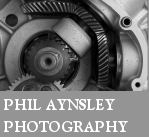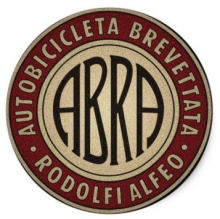



Alfeo Rodolfi established Autobicicletta Brevettata Rodolfi Alfeo in Bologna using both DKW and, from 1924, their own 132cc two-stroke engines. A limited number of motorcycles were built between 1923 and 1927
Nel 1923 erano in vendita i modelli Viaggio, Signore e Sacerdoti, Sport, dotati di DKW 118 cc; nel 1924 un’ABRA Sport modificata aveva partecipato ad alcune competizioni. Nuovi motori DKW di 132 e 170 cc, disponibili dal 1925, avevano permesso di migliorare la bicicletta a motore e di allestire una motoleggera.
La realizzazione di un cycle-car e l’applicazione di motori DKW alle imbarcazioni e ad un aliante avevano distolto Rodolfi dalla produzione agonistica, allora importante fattore promozionale. Negli anni Venti egli non era il solo rivenditore di motocicli con DKW; inoltre, le moto bolognesi G.D e M.M., con motori propri, si imponevano in ambito nazionale sia dal punto di vista commerciale che sportivo. L’ABRA aveva tentato di resistere alla concorrenza delle altre ditte con nuovi modelli ed una motoleggera da 170 cc. Nonostante tanta tenacia, Rodolfi non aveva saputo trasformare l’azienda artigiana in una vera e propria industria.
A conclusione della sua carriera, negli anni Cinquanta, si era dedicato alle riparazioni ed all’assistenza in una modesta officina in Via Croce. Alfeo Rodolfi riposa nel Campo 1962 della Certosa, sotterraneo, corsia interna ovest.
Alfeo Rodolfi (1894-1972), former technician of the Military Arsenal, starting from 1919 had managed the Garage d'Azeglio in Viale Aldini where, the following year, the production of a chassis designed for a DKW engine, probably the first product of the Bolognese motorcycle industry, with the ABRA brand (Rodolfi Alfeo Patented Autobicycle).
In 1923 the Viaggio, Signore e Sacerdoti, Sport models were on sale, equipped with DKW 118 cc; in 1924 a modified ABRA Sport had participated in some competitions. New 132 and 170 cc DKW engines, available since 1925, had made it possible to improve the motorized bicycle and to set up a light motorcycle.
The creation of a cycle-car and the application of DKW engines to boats and a glider had distracted Rodolfi from competitive production, an important promotional factor at the time. In the 1920s he was not the only motorcycle dealer with DKW; moreover, the GD and MM Bolognese motorcycles, with their own engines, imposed themselves on the national scene both from a commercial and sporting point of view. ABRA had tried to stand up to competition from other companies with new models and a 170 cc lightweight motorbike. Despite such tenacity, Rodolfi had not been able to transform the artisan company into a real industry.
At the end of his career, in the 1950s, he dedicated himself to repairs and assistance in a modest workshop in Via Croce. Alfeo Rodolfi rests in the Campo 1962 of the Certosa, underground, inside west lane.
Antonio Campigotto. from "La Ruota e l’Incudine la memoria dell’Industria Meccanica bolognese in Certosa", Minerva, 2016.
Musei Patrimonio Industriale;
Source Bolgna Musei Storia e Memoria
Models:
ABRA Viaggio 1923
Engine: DKW horizontal two-stroke single. Bore/stroke 50x60mm. Capacity 117.7cc
Ignition: flywheel magneto
Lubrication: petrol-oil mixture
Gearbox: 3:1 reduction
Final drive: Belt
Frame: Single cradle, steel tube
Wheels: 700x38B tyres
Maximum speed: 45 km/h
ABRA Sport 1924
Engine: DKW vertical 2-stroke single. Bore/stroke 52.5x60mm. Displacement 129.8 cc
Ignition: flywheel magneto
Lubrication: with petrol-oil mixture
Primary transmission: gears
Gears: 2-speed
Final drive: belt
Frame: simple cradle, steel tube
Wheels: 26x2 tyres
Maximum speed: 65-70 km/h
ABRA Sport 1925
Engine: DKW vertical 2-stroke single. Bore/stroke 52.5x60mm Displacement: 129.8cc
Ignition: flywheel magneto
Lubrication: petrol-oil mixture
Primary transmission: gears
Gearbox: 2-speed
Final drive: belt
Frame: tubular cradle
Wheels: tyres 26x2
Maximum speed: 75 km/h
Rodolfi Engine
Specification
Type: auxiliary motor
Production Year: late 20s early 30s
Engine: single-cylinder inclined 2-stroke. Bore/stroke 38.8x41mm, 48.4 cc
Ignition: Dansi flywheel
Lubrication: petrol-oil mixture
Sources: Tragatsch p72; correspondence; Musei Patrimonio Industriale;
Source Bolgna Musei Storia e Memoria.
If you have a query or information about these classic Italian machines, please contact us